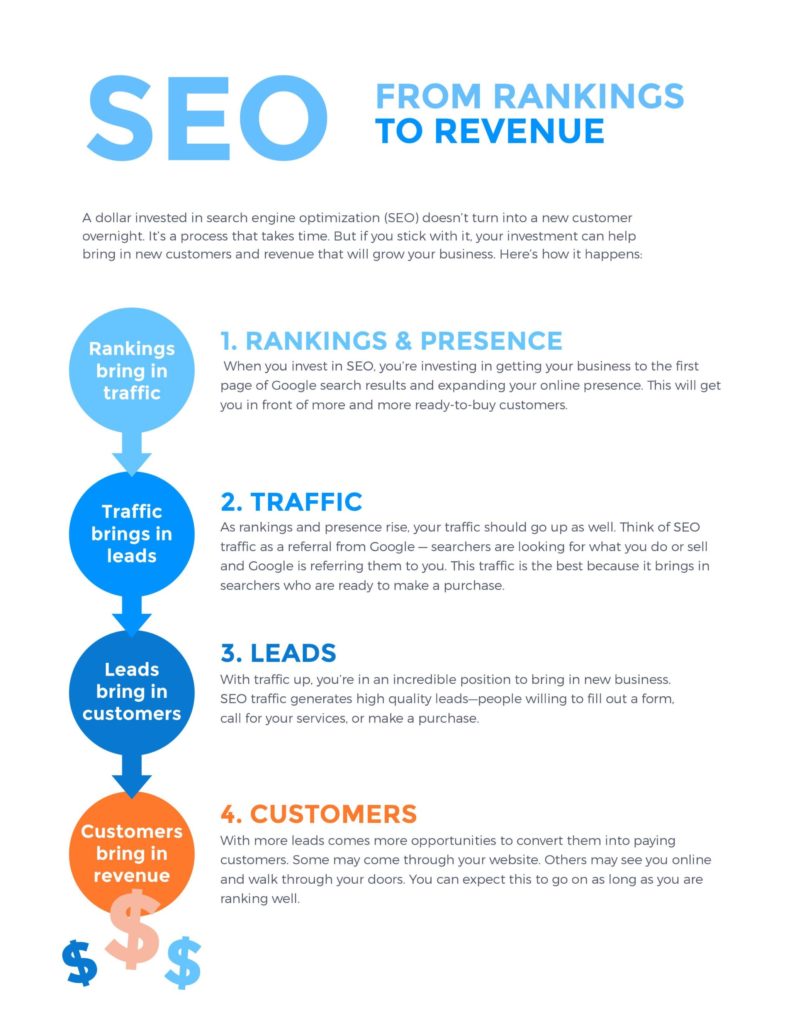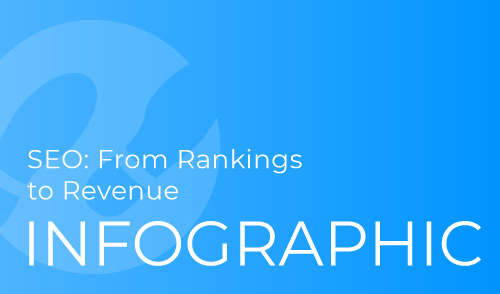SEO is a versatile marketing activity that can help you increase brand awareness, manage your reputation, increase web traffic, drive leads, increase conversions, and boost sales.
How does SEO accomplish so much? Proper SEO strategies focus on long-term gains through sustainable activities which boost your website rank in the SERPs. Better rankings increase your presence multiple places online which increases the chances of people finding and visiting your website. With proper UI design and a good user experience, those visits convert to leads and then into paying customers.
Since SEO focuses on long-term, sustainable wins, SEO investment doesn’t convert into sales immediately. SEO activities don’t even get people through the door or onto your website immediately. But over time, a good, consistent SEO strategy gets a lot of people through the door and those visits equal dollars in the bank.
The infographic at the end of this article shows the flow from revenue to rankings as a result of consistent SEO practices. Let’s walk through each step from rankings to revenue and take a look at how SEO helps you grow your business.
1. Rankings & Presence
In simple terms, SEO helps move your website up in the results of a Google search–ideally to the top of page one. But SEO also helps you increase your online presence in more ways than just traditional, organic search rankings.
Expertly-optimized websites can show up in a variety of ways on a SERP. For local businesses, featuring in a local pack is a huge win. Listing in business directories such as Yelp and Yellow Pages is another way to increase your presence on a SERP.
Done correctly, SEO gets you in front of ready-to-buy customers multiple ways, which dramatically increases the chances of people clicking on and visiting your website.
2. Traffic
How much traffic can you command on Google’s first page? Upward of 75% of people don’t even venture to the second page, either finding what they’re looking for on page one, or refining their search to get better page-one results.
This means that as you climb the search results–particularly if you have a presence multiple places on page one–your traffic potential increases exponentially.
Think of it this way: Google’s goal is to serve its users with the best results possible. So if you show up on Google’s first page, Google is essentially telling people your website is worth visiting. And a referral from Google is about the best referral you can get.
3. Leads
Converting traffic into leads can be easy with a good SEO campaign. The traffic generated by your SEO efforts is high quality since Google channels people to you who truly are searching for your products or services. This means your visitors are ready to take some sort of action such as signing up for a newsletter, downloading an ebook, or making a purchase.
At this stage, the user interface of your landing pages becomes extremely important. You’ve already optimized your landing pages as part of your SEO efforts. The visitors to those pages want whatever you’re offering. So you definitely don’t want to lose people at this stage due to poor loading times or a confusing interface.
Additionally, if people leave your website without taking any action, your bounce rate increases. A high bounce rate from your landing pages signals to Google that you aren’t meeting the searchers’ needs. This negatively impacts your SEO and will hurt your rankings.
4. Customers
The increase in quality traffic and leads provides you with more opportunities to convert your visitors into paying customers. SEO gets people to your website. Generating revenue is up to you. If your visitors have a good first experience, you can convert them into lifelong customers and brand advocates.
Like any marketing activity, SEO cannot make up for poor products, services, or customer experiences. Moreover, negative customer experiences hurt your SEO efforts. Search engines use negative reviews and negative sentiment on social media as signals to move your website down in the search results. On the other hand, positive reviews and praise on social media are positive ranking signals to search engines.
SEO largely focuses on generating digital traffic, leads, and customers, specifically to your website. Yet SEO helps drive traffic to businesses that have physical locations as well. Ranking in local packs and having a consistent, positive presence across the web enables mobile searchers to find and patron your business in person. As long as you’re ranking well online, you can expect more and higher-quality foot traffic to your physical store as well.
Conclusion
The SEO path from rankings to revenue is an upward spiral. SEO best-practices increase your rankings and online presence. Those rankings drive more high-quality traffic which translates into leads. Those leads can then be converted into happy, paying customers.
Those happy, paying customers generate good reviews, increased traffic to your website, and positive social media. Search engines reward all of these positive signals which increases the strength of your SEO efforts. Stronger SEO efforts increase your rankings, online presence, traffic, etc. and so on. It’s a win win!










